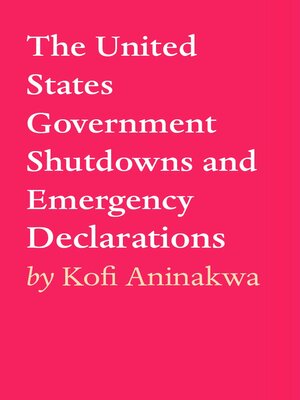The United States Government Shutdowns and Emergency Declarations
ebook ∣ Facts to Remember
By Kofi Aninakwa

Sign up to save your library
With an OverDrive account, you can save your favorite libraries for at-a-glance information about availability. Find out more about OverDrive accounts.
Find this title in Libby, the library reading app by OverDrive.



Search for a digital library with this title
Title found at these libraries:
| Library Name | Distance |
|---|---|
| Loading... |
A government shutdown occurs when Congress does not approve of or the President rejects the federal budget for the upcoming fiscal year. Since the 1990s, Congress has often failed to pass the twelve to thirteen appropriation bills that set government-wide spending.
In their stead they pass "continuing resolutions (CR)" to extend the existing spending law at or near current levels, and "omnibus" bills that combine many appropriations bills into one.
The National Emergencies Act (NEA) of 1976 allows the president to declare a national emergency, but he must outline the specific emergency powers he is using under existing statutes. According to the Brennan Center's running count, 32 of these are still in effect—including the ban on Iranian property, which was extended in November of 2018.
In their stead they pass "continuing resolutions (CR)" to extend the existing spending law at or near current levels, and "omnibus" bills that combine many appropriations bills into one.
The National Emergencies Act (NEA) of 1976 allows the president to declare a national emergency, but he must outline the specific emergency powers he is using under existing statutes. According to the Brennan Center's running count, 32 of these are still in effect—including the ban on Iranian property, which was extended in November of 2018.







